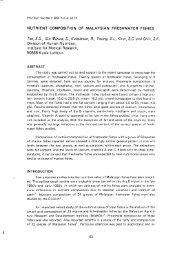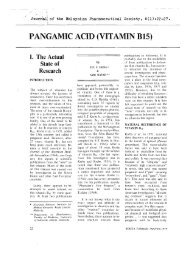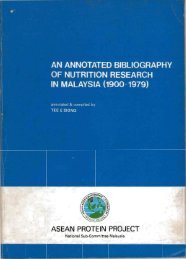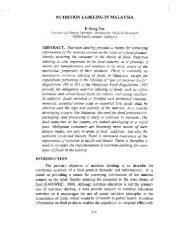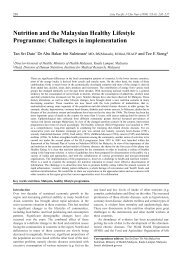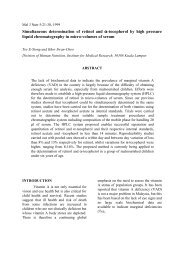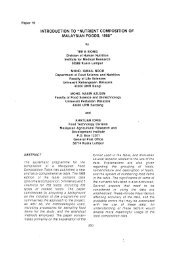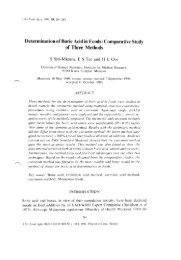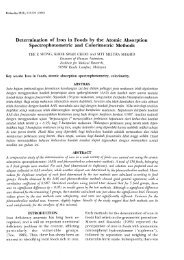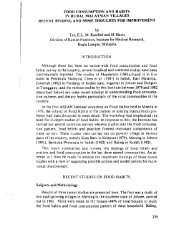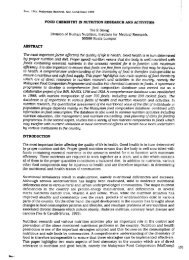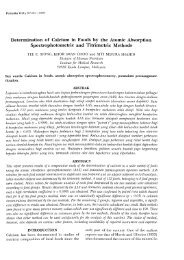Current status of recommended dietary allowances in Southeast Asia
Current status of recommended dietary allowances in Southeast Asia
Current status of recommended dietary allowances in Southeast Asia
You also want an ePaper? Increase the reach of your titles
YUMPU automatically turns print PDFs into web optimized ePapers that Google loves.
April 1998: S"IO-S18<br />
<strong>Current</strong> Status <strong>of</strong> Recommended Dietary Allo'wances <strong>in</strong><br />
<strong>Southeast</strong> <strong>Asia</strong>: A Regional Overview<br />
E-SiongTee<br />
Introduction<br />
This is probably the first time that scientists <strong>in</strong> <strong>Southeast</strong><br />
<strong>Asia</strong> have gathered to discuss <strong>in</strong> depth the <strong>recommended</strong><br />
<strong>dietary</strong> <strong>allowances</strong> (RDAs) <strong>in</strong> these countries, their utilization,<br />
and future developments, The <strong>in</strong>teraction among<br />
scientists <strong>in</strong> the region should br<strong>in</strong>g about mutual benefits,<br />
The presence <strong>of</strong>experts from the Food and Agriculture<br />
Organization/World Health Organization (FAOIWHO)<br />
and the United States should provide valuable <strong>in</strong>put <strong>of</strong><br />
experiences from all over the world and fmm the country<br />
with the most advanced research <strong>in</strong> nutrient requirements.<br />
It was believed that a situational analysis <strong>of</strong> the currently<br />
available RDAs <strong>in</strong> the <strong>Southeast</strong> <strong>Asia</strong>n region could<br />
provide useful <strong>in</strong>put for the workshop discussions. This<br />
overview attempts to collate and analyze the RDAs <strong>in</strong> the<br />
region for commonalities and differences and to highlight<br />
specific and special features. It is hoped that this paper<br />
will serve as background <strong>in</strong>fonnation for further deliberations<br />
dur<strong>in</strong>g the workshop and discussion sessions.<br />
For this purpose, RDAs currently <strong>in</strong> USI~ <strong>in</strong> the follow<strong>in</strong>g<br />
six <strong>Southeast</strong> <strong>Asia</strong>n countries were obta<strong>in</strong>ed for the<br />
review: Indonesia,1 Malaysia,2 Philipp<strong>in</strong>es,3 S<strong>in</strong>gapore,4<br />
Thailand,s and Vietnam. 6 In addition, recommendations<br />
from WHOIFA0 7 - 9 as well as RDAs used <strong>in</strong> the United<br />
States10 were <strong>in</strong>cluded for comparison. Brunei Darussalam<br />
uses a comb<strong>in</strong>ation <strong>of</strong> several RDAs, esp(!cially the Malaysian<br />
and British RDAs. Recommendations for the most<br />
relevant nutrients <strong>in</strong> the region-----namely, energy, prote<strong>in</strong>,<br />
calcium, iron, vitam<strong>in</strong> A, thiam<strong>in</strong>, rib<strong>of</strong>lav<strong>in</strong>, folate, vitam<strong>in</strong><br />
B 12<br />
, vitam<strong>in</strong> C (ascorbic acid), and iod<strong>in</strong>e-are tabulated<br />
and compared for the different countries and accord<strong>in</strong>g<br />
to age.<br />
Documentation <strong>of</strong> the RDAs received were <strong>in</strong>complete<br />
<strong>in</strong> most cases, where only the nutrients tabulated<br />
were received by the author. The development process or<br />
steps and the rationale for the levels <strong>of</strong>the various recom- ~<br />
Dr. Tee is Head <strong>of</strong> the Division <strong>of</strong> Human Nutrition<br />
at the Institute for Medical Research, 50588 Kuala<br />
Lumpur, Malaysia.<br />
mendations were thus unclear. Some <strong>of</strong> these aspects,<br />
especially with regard to current and future developments<br />
<strong>in</strong> the review <strong>of</strong>national RDAs, are reported here<strong>in</strong> by the<br />
representatives from various countries.<br />
General Comparison:s<br />
The various RDAs have widely differ<strong>in</strong>g years <strong>of</strong> implementation;<br />
the oldest is the Malaysian RDA, which was<br />
<strong>in</strong>troduced <strong>in</strong> 1975. Most <strong>of</strong>the RDAs were <strong>in</strong>troduced <strong>in</strong><br />
the late 1980s.or early 1990s. The Vietnamese RDA was<br />
adopted by various sectors <strong>in</strong> the country and was formally<br />
signed by the M<strong>in</strong>ister <strong>of</strong>Health <strong>in</strong> September 1996.<br />
Indonesia also has high political back<strong>in</strong>g <strong>of</strong> the RDA,<br />
which was <strong>of</strong>ficially rele:ased as a decree <strong>of</strong>the M<strong>in</strong>ister <strong>of</strong><br />
Health <strong>in</strong> 1994. Several versions <strong>of</strong> the WHO lIDA for<br />
specific nutrients are used <strong>in</strong> this review. The nutrients<br />
listed differ widely, but the core group <strong>of</strong>nutrients is similar;<br />
the most common ones are energy, prote<strong>in</strong>, calcium,<br />
iron, thiam<strong>in</strong>, rib<strong>of</strong>1av<strong>in</strong>, niac<strong>in</strong>, vitam<strong>in</strong> A, folate, vitam<strong>in</strong><br />
B and vitam<strong>in</strong> C. Thailand and the United States also<br />
12 ,<br />
listed requirements for several other micronutrie:nts.<br />
The different RDAs adopted different age group<strong>in</strong>gs,<br />
especially from adolescents onward. Indonesia, Malaysia,<br />
Philipp<strong>in</strong>es, and Thailand refer to adults from 20 years<br />
onward; S<strong>in</strong>gapore, Vietnam, the United States, a.nd WHO<br />
use 18 years and above. In the RDAs for the Uni':ed States<br />
and Indonesia (female), requirements for adults over 50<br />
years old are separately li~ted; requirements for adults<br />
over 60 years <strong>of</strong> age are separately listed for Indonesia<br />
(male), S<strong>in</strong>gapore, Thailand, and Vietnam. For Malaysia<br />
and the Philipp<strong>in</strong>es, a cut<strong>of</strong>f <strong>of</strong> 70 years is used for older<br />
adults. With the excep1Cion <strong>of</strong> Malaysia and Vietnam, the<br />
median weight and height for each age group <strong>in</strong> the RDAs<br />
are given.<br />
Comparison <strong>of</strong> RDAs is complicated by the use <strong>of</strong><br />
different body weights <strong>in</strong> different countries. Body weights<br />
used <strong>in</strong> the US RDA are the highest for all age groups <strong>in</strong><br />
all countries studied. WHO uses a wide range <strong>of</strong> body<br />
weights for each age group. Among the <strong>Southeast</strong> <strong>Asia</strong>n<br />
countries, body weights used also differ considerably for<br />
all age groups.<br />
S10 Nutrition Reviews, Vol. 56, No. 4
Energy Requirements<br />
sia and the United States, which provide for a marg<strong>in</strong>ally<br />
higher level <strong>of</strong> total daily requirement (Table 1) (86-112<br />
Energy requirement is the subject <strong>of</strong> extensiv1e studies <strong>in</strong> kcal for <strong>in</strong>fants and 66-124 kcal for children) However,<br />
various countries <strong>in</strong> the region. Although undernutrition, because the United States uses a higher median body<br />
<strong>in</strong>clud<strong>in</strong>g energy <strong>in</strong>take, is still a concern <strong>of</strong> large seg- weight, the requirement per kilogram <strong>of</strong> body wei,?;ht is<br />
ments <strong>of</strong>the population <strong>in</strong> <strong>Southeast</strong> <strong>Asia</strong>n countries, the similar to that <strong>of</strong> other countries tabulated, whereas the<br />
problem <strong>of</strong> energy excess, obesity, and the associated Malaysian RDA appears to be higher.<br />
chronic diseases has <strong>in</strong>creased <strong>in</strong> importance. Recommen- Provisions for adolescent boys are higher than those<br />
dations for energy <strong>in</strong>take therefore dom<strong>in</strong>ate the attention for girls <strong>in</strong> all RDAs reviewed (1850-JOOO and 1700--2350<br />
<strong>of</strong> workers <strong>in</strong> the region. It is necessary to exam<strong>in</strong>e the kcal, respectively). There is also general agreement <strong>in</strong> all<br />
recommendations <strong>in</strong> relation to the altered lifestyles <strong>of</strong> the recommendations for these two groups <strong>of</strong> subjects.<br />
those populations.<br />
The possible exceptions an:: aga<strong>in</strong> Malaysia and the United<br />
Recommendations for <strong>in</strong>fants and young children are States, which provide for higher total <strong>in</strong>takes per day. The<br />
rather similar <strong>in</strong> all the RDAs, with the exception <strong>of</strong>Malay- amount <strong>recommended</strong> per kilogram <strong>of</strong> body weight for the<br />
Table 1. RDAs <strong>in</strong> Selected <strong>Southeast</strong> <strong>Asia</strong>n Countries: Energy<br />
Age Group Indonesia Malaysia Philipp<strong>in</strong>es S<strong>in</strong>gapore Thailand Vietnam WHO USA<br />
(years) (1994) (1975) (1989) (1988) (1989) (1996) (1985) (1989'1<br />
Infants, 0--1<br />
kcalperday 560-800 784-1064<br />
body weight (kg) 5.5-8.5 7-9.5 a 620-880 700-950 600-800 620-820 700--950 650-850<br />
6-9 7--9.5 6--8 7-9.5 3 7-9.5 6-9<br />
kcalperkg 102--94 112 103--98 100 100 89--86 leX) 108--94<br />
Children, 1-9<br />
kcal per day 1250--1900 1360--2190 1350--1740 1150--2100 1200--1450 1300--1800 1150-2100 1300--2COO<br />
body weight (kg) 12-24 11-27a 13-24 11-27 12-22 11-27 3 11--27 13-28<br />
kcal per kg 104-79 124-81 104-73 105-78 100--66 118-67 105-78 100--71<br />
Boys, 10--19<br />
kcal per day<br />
body weight (kg)<br />
2000--2500 2600-2580 2090-2580 22CKJ-2850 1850--2400 2200--2700 2200-2800 2500--3000<br />
30--56 34.5-64 3 32-55 34.5-64 29-54 34.5---{)43 34..5-64 45-66<br />
kcal per kg 67-45 75-40 65-47 64-45 64--44 64-42 64--44 56-45<br />
Girls, 10--19<br />
kcal per day 1900---2000 2350--2100 1910--2020 1950---2150 1700--1850 2100--2300 1950--2150 2200<br />
body weight (kg) 35-50 36-54 a 35-48 36-54 31-48 36-54 a 36-54 46--55<br />
kcalperkg 54-40 65-39 55-42 54-40 55-39 58-42 54-40 48-40<br />
Male,20--59 b<br />
kcal per day 3roJ 2530--2020 2570--2090 2950--2900 2800--2750 27CX) 2650-325Qd 2~<br />
body weight (kg) 62 55 56 63.5 58 50-8oa 50-80 72-79<br />
kcal per kg 48 46-37 46--37 46 48-47 54--34 53-41 40--37<br />
Male, ?:60 c<br />
kcal per day 2200 1770 1880 2450 2250 22CX) 2100-28O()d 2300<br />
body weight (kg) 62 55 56 63.5 58 50-80" 50--80 77<br />
kcal per kg 35 32 34 39 39 44-28 42-35 30<br />
Female,20--59 b<br />
kcalperday<br />
body weight (kg)<br />
2250 2000-1600 1900--1540 2100--2150 2CXXJ 23CX)<br />
54 50 49 54 50 40--75 3 2150--27O()d 22CX)<br />
40-75 58-{j]<br />
kcalper kg 42 40--32 39-31 39--4D 40 58--31 54-36 38--35<br />
Female, ?:60 C<br />
kcalperday 1850 1400 1390 1~ 1850 1800 1850-2500 1~'<br />
body weight (kg) 54 50 49 54 50 40--75 3 40-75 65<br />
kcal per kg 34 28 28 35 37 45-24 46-33 ~<br />
Pregnancy<br />
1 st trimester +285 +150 +0 +200--285 +300 +0 +200-285 -t{)<br />
2nd trimester +285 +350 +300 +200--285 +300 +350 +200--285 +3CX)<br />
3rd trimester +285 +350 +300 +200--285 +300 +350 +2()()"-285 +3CX)<br />
Lactation<br />
1st 6 months +700 +550 +500 +)00 +500 +550 +500 +500<br />
2nd 6 months +500 +0 +500 +500 +500 +0 +500 +500<br />
For adults, only requirements at moderate activity levels are given, <br />
3Body weights not given by the Malaysian and Vietnamese RDAs but taken from WHO, <br />
b2~9 years for Malaysia, Philipp<strong>in</strong>es; 18-59 years for S<strong>in</strong>gapore, WHO; 19--50 for US RDA. <br />
US RDA, however, is rather similar to other countries (45- rather similar <strong>in</strong> all countries and range from 200 to 300<br />
67 kcal for boys and 39-55 kcal for girls) as it uses a higher kcal per day dur<strong>in</strong>g pregnancy and around 500 kcal per<br />
median body weight; that for the Malaysian RDA is the day dur<strong>in</strong>g lactation. Some countries, however, do not<br />
highest (40-75 kcal for boys and 39-65 for girls).<br />
provide for additional energy <strong>in</strong>take <strong>in</strong> the first tnmester<br />
All countries have <strong>recommended</strong> higher daily energy <strong>of</strong>pregnancy or it is provided for at a lesser amount. Marequirements<br />
for adult men than for women <strong>of</strong> the same laysia and Vietnam do not provide for additional energy<br />
age group (2000-3000 and 1500-2700 kcal, respectively). <strong>in</strong>take <strong>in</strong> the latter half <strong>of</strong>the lactation period.<br />
All RDAs tabulated have also <strong>recommended</strong> lower <strong>in</strong>takes<br />
for older <strong>in</strong>dividuals (>60 years) than for young adults Prote<strong>in</strong> Requirements<br />
and higher <strong>in</strong>takes for males than for females ( 1800-2800 Prote<strong>in</strong> deficiency has decl<strong>in</strong>ed <strong>in</strong> importance fer many<br />
for older men and 1400-2500 for older women). In terms <strong>of</strong> population groups <strong>in</strong> countries <strong>in</strong> the region. All counkilocalories<br />
per kilogram <strong>of</strong> body weight, levels are rather tries, however, cont<strong>in</strong>ue to place importance on monitorsimilar<br />
<strong>in</strong> all countries, although slightly higher values <strong>in</strong>g the prote<strong>in</strong> <strong>status</strong> <strong>of</strong> communities and ensur<strong>in</strong>g that<br />
may be noted for Vietnam and WHO with somewhat lower <strong>recommended</strong> requirements are met.<br />
levels for Malaysia and the Philipp<strong>in</strong>es.<br />
All countries listed a prote<strong>in</strong> requirement after hav-<br />
Provisions have been made for additional energy <strong>in</strong>- <strong>in</strong>g adjusted for the prote<strong>in</strong> quality <strong>of</strong> the diet (Table 2).<br />
take dur<strong>in</strong>g pregnancy and lactation for all countries. The Most <strong>Southeast</strong> <strong>Asia</strong>n countries used a prote<strong>in</strong> quality or<br />
additional amounts over and above the daily <strong>in</strong>takes are net prote<strong>in</strong> utilization (NPU) <strong>of</strong>70, Vietnam used a value <strong>of</strong><br />
Table 2. RDAs <strong>in</strong> Selected <strong>Southeast</strong> <strong>Asia</strong>n Countries: Prote<strong>in</strong><br />
Age Group Indonesia Malaysia Philipp<strong>in</strong>es S<strong>in</strong>gapore Thailand Vietnam \\t1l0 USA<br />
(years) (1994) (1975) (1989) (1988) (1989) (1996) (1985) (1989)<br />
Infants, 0-1<br />
g per day 12-15 16.8-13.3 NS-14 16--18 NS-14 21--23 13-14 13-14<br />
body weight (kg) 55-8.5 7-9.5 3 6-9 7-9.5 4-S 7-9.5 a 7-9.5 6-9<br />
g per kg. 2.2-1.8 2.4-1.4 NS-l.6 2.3--1.9 NS-I.8 3.0--2.4 1.9-1.5 2.2-1.6<br />
Children, 1-9<br />
g per day 23-37 23-35 27-35 19--39 17-26 28-40 13.5-27 16-28 b<br />
body weight (kg) 12-24 11-27a 13-24 11-27 12-22 11--27a 11-27 13-28<br />
gper kg 1.9--1.5 2.1-1.3 2.1--1.5 1.7--1.4 1.4-1.2 2.6-1.5 1.2--1.0 1.2-1.0<br />
Boys, 10-19<br />
g per day 45-66 43-54 4.5-69 49--80" 34-57 50--65 34-56 c 45-.5g
60, and Thailand used a digestibility value <strong>of</strong>85%. WHO<br />
and the US RDA assume a good quality or reference prote<strong>in</strong><<br />
All RDAs for children are given <strong>in</strong> a range--e.g., 12<br />
18 g per day for <strong>in</strong>fants, except for Vietnam, which provides<br />
for a higher <strong>in</strong>take <strong>of</strong>21-23 g. For children less than<br />
10 years old and adolescents, higher amounts (23-37 g)<br />
are <strong>recommended</strong> by Indonesia, Malaysia, Philipp<strong>in</strong>es,<br />
S<strong>in</strong>gapore, and Vietnam. The other three RDAs (Thailand,<br />
WHO, and the United States) have lower recommendations,<br />
rang<strong>in</strong>g from 13.5 to 28.0. Intake further <strong>in</strong>creases to<br />
43-69 g per day for all countries except Thailand and the<br />
United States and WHO, which recommend 34--59 g. For<br />
some RDAs, amounts <strong>recommended</strong> for girls are marg<strong>in</strong>ally<br />
higher than for boys.<br />
Recommendations for adult women are lower than<br />
those for men (37.5-68 versus :3 7-58 g). There are considerable<br />
variations among the recommendations for the various<br />
RDAs. WHO and the United States are the only RDAs<br />
that give a range for prote<strong>in</strong> requirements. All RDAs recommend<br />
additional amounts <strong>of</strong>prote<strong>in</strong> dur<strong>in</strong>g pregnancy,<br />
rang<strong>in</strong>g from 6 to 15 g per day, most <strong>of</strong> which is for the<br />
duration <strong>of</strong> the pregnancy. Dur<strong>in</strong>g lactation, higher additional<br />
amounts <strong>of</strong>prote<strong>in</strong> are <strong>recommended</strong> for all RDAs,<br />
with amounts rang<strong>in</strong>g from 12 to 28 g per day.<br />
Based on grams <strong>of</strong> prote<strong>in</strong> per kilogram <strong>of</strong> body<br />
weight, the <strong>recommended</strong> prote<strong>in</strong> requirements for WHO<br />
and the US RDA for all age groups are very similar and are<br />
generally lower than for the other RDAs. There is more<br />
variation among other countries, with the RDA for Vietnam<br />
provid<strong>in</strong>g the highest <strong>in</strong>takes.<br />
Requirements for Calcium and Iron<br />
Calcium<br />
Documentation <strong>of</strong> calcium deficiency is much less than<br />
for the other nutrients. However, the importance <strong>of</strong> the<br />
problem <strong>of</strong>osteoporosis, a chronic disorder, has been highlighted<br />
<strong>in</strong> recent years. To detenn<strong>in</strong>e whether the recommendations<br />
are adequate, it is first necessary to detenn<strong>in</strong>e<br />
the extent and severity <strong>of</strong> the deficiency.<br />
Recommendations for calcium <strong>in</strong>take for <strong>in</strong>fants were<br />
similar for all the RDAs studied. Notable differences are<br />
observed for the other age groups, however, and are generally<br />
higher for Thailand and the United States. For children<br />
and adults, the Thai and US RDAs provide for 300-<br />
1200 mg per day, whereas the recommendations for the<br />
other countries range from 450 t0700 mg per day. There<br />
were no differences <strong>in</strong> recommendations accord<strong>in</strong>g ta sex<br />
(Table 3).<br />
The US RD A does not provide a greater requirement<br />
for pregnant and lactat<strong>in</strong>g women, but recommendations<br />
for adults (800--1200 mg) are higher than <strong>in</strong> other countries.<br />
The additional amounts <strong>recommended</strong> dur<strong>in</strong>g pregnancy<br />
and lactation <strong>in</strong> the other countries are similar and<br />
range from 400 to 700 mg per day.<br />
Iron<br />
Recommendations for <strong>dietary</strong> iron <strong>in</strong>take will cont<strong>in</strong>ue to<br />
be <strong>of</strong>considerable <strong>in</strong>terest to nutrition workers <strong>in</strong> the region<br />
<strong>in</strong> view <strong>of</strong> the cont<strong>in</strong>ued high prevalence <strong>of</strong> irc'n deficiency<br />
anaemia, particularly among young children and<br />
women <strong>of</strong>childbear<strong>in</strong>g age.<br />
As expected, recommendations for iron are the highest<br />
for adult women (6-28 mg per day) to meet <strong>in</strong>creased<br />
needs and decl<strong>in</strong>e sharply after 50 years <strong>of</strong> age to :evels<br />
similar to those for adult men (6-13 mg per day). The second<br />
highest recommendations for iron are for 10- 10 19<br />
year-old boys and girls (7-23 mg per day) (Table 4)<br />
No additional amounts are <strong>recommended</strong> for pregnant<br />
women by Malaysia, S<strong>in</strong>gapore, and WHO. Indonesia,<br />
Philipp<strong>in</strong>es, and Thailand recommend relatively high<br />
amounts <strong>of</strong> 15-41 mg per day, whereas Vietnam <strong>recommended</strong><br />
only 6 mg per day. Dur<strong>in</strong>g lactation, only Philipp<strong>in</strong>es<br />
(23 mg per day) and Indonesia (2 mg per day) <strong>recommended</strong><br />
additional iron <strong>in</strong>take.<br />
In general, recommendations for Indonesia, Malaysia,<br />
Philipp<strong>in</strong>es, and Vietnam are higher than those for the<br />
Table 3. RDAs <strong>in</strong> Selected <strong>Southeast</strong> <strong>Asia</strong>n Countries: Calcium (mg per day)<br />
Age Group Indonesia Malaysia Philipp<strong>in</strong>es S<strong>in</strong>gapore Thailand Vietnam WHO USA<br />
(years) (1994) (1975) (1989) (1988) (1989) (1996) (1988) (1989)<br />
Infants, 0-1 600-400 550 300-600 500--600 360-480 300--500 500--600 4OO-6OJ<br />
Children, 1-9 500 450 600 4OG-500 800 500 400-500 800<br />
Boys, 10-19 700-600 650--500 700 6OG-500 1200 700 600--700 1200<br />
Girls, 10-19 700-600 650--500 700 6OG-500 1200 700-600 600--700 1200<br />
Men,~20 500 450 500 400--500 800 500 400--500 120G-800<br />
Women,~20<br />
500 450 500 400:-500 800 500 400--500 120G-800<br />
Pregnancy<br />
1 st trimester +400 +0 +400 +600-700 +400 +0 +0 +0<br />
2nd trimester +400 +750 +400 +600--700 +400 +500 +600-700 +0<br />
3rd trimester +400 +750 +400 +6CIO-700 +400 +500 +600--700 +0<br />
Lactation<br />
1st 6 months +400 +750 +400 +600-700 +400 +500 +600-700 +0<br />
2nd 6 months +400 +0 +400 +600-700 +400 +0 +0 +0<br />
Nutrition Reviews, Vol. 56, No.4 $13
Table 4. RDAs <strong>in</strong> Selected <strong>Southeast</strong> <strong>Asia</strong>n Countries: Iron (mg per day)<br />
Age Group Indonesia Malaysia Philipp<strong>in</strong>es S<strong>in</strong>gapore Thailand Vietnam WHO USA<br />
(years) (1994) (1975Y· (1989)b (1988y (1989) (1996) (1988)d (1989)<br />
Infants, 0-1 3-5 10 10-15 7 M3 10-11 7 6-10<br />
Children, 1-9 8--10 10 9-12 7 10 6--12 4----S 10<br />
Boys, 10-19 14-23-13 10-18 16-18-17 7-12--6 12--10 12-11 8-12 12<br />
Girls, 10-19 14-25-16 10-28 17-25 7--19 15 12-24 8-13 15<br />
Men, ~20 l3 9 12 6 10 11 8 10<br />
Women, 2:20 26--14 28--9 26-11 19--{) 15-10 24-9 14-6 15--10<br />
Pregnancy<br />
1 st trimester +30 -t{) +41 -t{) +30 -t{) -t{) +l5 <br />
2nd trimester +30 -t{) +41 -t{) +30 +6 -t{) +15 <br />
3rd trimester +30 -t{) +41 -t{) +30 +6 -t{) +15 <br />
Lactation<br />
1st 6 months +2 -t{) +23 -+{) -t{) -t{) -t{) -f{)<br />
2nd 6 months +2 -t{) +23 -t{) -t{) -t{) -t{) -f{)<br />
"Iron absorption from diet assumed to be 10°1t). <br />
bRate <strong>of</strong> absorption <strong>of</strong> iron from average Filip<strong>in</strong>o diet is 8.2%. <br />
cValues apply when 1~25% <strong>of</strong> energy <strong>in</strong> diet comes from animal foods. <br />
dAdequate to prevent development <strong>of</strong> overt anaemia for <strong>in</strong>termediate bioavailability diet (10%). <br />
other countries. Most <strong>of</strong> the RDAs <strong>in</strong>dicate a rate <strong>of</strong> iron <strong>in</strong>fants to adults. Recommendat:lOns <strong>in</strong> the Uni :ed States <br />
absorption from the diet (usually 10%), which <strong>in</strong>fluences are clearly higher and range from 375 to 1000 pg RE per <br />
the <strong>recommended</strong> <strong>in</strong>take.<br />
day (Table 5). <br />
Recommendations for additional ret<strong>in</strong>ol dur<strong>in</strong>g preg<br />
Recommendations for Several Vitam<strong>in</strong>s<br />
nancy are more conservative. Malaysia, S<strong>in</strong>gapore, and <br />
the United States do not suggest additional reql.irements. <br />
There has been a great deal <strong>of</strong> <strong>in</strong>terest <strong>in</strong> the <strong>in</strong>take <strong>of</strong><br />
Indonesia, Thailand, and WHO recommend an additional<br />
several vitam<strong>in</strong>s <strong>in</strong> relation to claims for prevention <strong>of</strong><br />
100-200 ~g RE per day, whereas an additional 25 ~g is<br />
chronic diseases. The importance <strong>of</strong>vitam<strong>in</strong> requirements,<br />
<strong>recommended</strong> by the Philipp<strong>in</strong>e RDA. All RDAS studied<br />
particularly the amounts needed, has been the subject <strong>of</strong><br />
provide for additional amounts <strong>of</strong> ret<strong>in</strong>ol dur<strong>in</strong>g lactation,<br />
much discussion and controversy. Focus is given to the<br />
<strong>in</strong> most cases rang<strong>in</strong>g from 275 to 500 ~g RE daily throughpossible<br />
role <strong>of</strong> vitam<strong>in</strong>s <strong>in</strong> conditions and diseases beout<br />
the 12-month lactation period.<br />
yond their classic functions. This <strong>in</strong>cludes the possible<br />
role <strong>of</strong> several vitam<strong>in</strong>s <strong>in</strong> cancer prevention.<br />
Thiam<strong>in</strong><br />
Vitam<strong>in</strong> A<br />
Recommendations for thiam<strong>in</strong> are rather similar for all coun<br />
Considerable differences <strong>in</strong> recommendations for vitam<strong>in</strong> tries, although requirements <strong>in</strong> the S<strong>in</strong>gapore RDA are<br />
A, especially dur<strong>in</strong>g pregnancy and lactation, are ob marg<strong>in</strong>ally lower. Levels <strong>recommended</strong> for boys and men<br />
served. Vitam<strong>in</strong> A requirements for all countries except (0.9-1.5 mg) are marg<strong>in</strong>ally higher than for girls and women<br />
the United States ranged from 300 to 700 ~g RE per day for (0.8-1.1 mg). All countries recommend additional vitam<strong>in</strong><br />
Table 5. RDAs <strong>in</strong> Selected <strong>Southeast</strong> <strong>Asia</strong>n Countries: Vitam<strong>in</strong> A (j.1g RE per day)<br />
Age Group Indonesia Malaysia Philipp<strong>in</strong>es S<strong>in</strong>gapore Thailand Vietnam WHO lfSA<br />
(years) (1994) (1975) (1989) (1988) (1989) (1996) (1988) (1989)<br />
Infants, 0-1 350 300 325 300 420-375 325-350 350 J75<br />
Children, 1-9 350-400 250-400 350-400 250-400 390-500 400 400 400-700<br />
Boys, 10-19<br />
45(}-{)OO 575-750 425-525 575-750 600-700 500-600 500-600 1000<br />
Girls, 10-19<br />
500 575-750 400-450 575-750 600 500--{)()0-500 500<br />
gOO<br />
Men, 2:20<br />
600 750 525 750 700 600 600 1000<br />
Women,~O<br />
500 750 450 750 600 500 500<br />
gOO<br />
Pregnancy<br />
1 st trimester +200 -t{) +25 -t{) +200 -t{) +100 -t{)<br />
2nd trimester +200 -t{) +25 -t{) +200 +100 +100 -t{)<br />
3rd trimester +200 -t{) +25 -t{) +200 +100 +100 -t{)<br />
Lactation<br />
1st 6 months +350 +450 +325 +450 +400 +300 +350 +500<br />
2nd 6 months +300 -t{) +275 +450 +320 -t{) +350 -+400<br />
514<br />
Nutrition Reviews, Vol. 56, No.4
Table 6. RDAs <strong>in</strong> Selected <strong>Southeast</strong> <strong>Asia</strong>n Countries: Thiam<strong>in</strong> (mg per day)<br />
Age Group Indonesia Malaysia Philipp<strong>in</strong>es S<strong>in</strong>gapore Thailand Vietnam WHO USA<br />
(years) (1994) (1975) (1989) (1988) (1989) (1996) (1976) (1989)<br />
Infants~ 0-1 0..3-0.4 0..4 0..3-0.4 0.28-0J8 0..3-0.5 0..3-0.4 0.04 D.:HJo4<br />
Children, 1-9 o.S-l.O 0..5-0.9 0..7-0.9 0..46-0.72 0..7-1.2 D.8-1J 0..5--0..9 0..7-1.0.<br />
Boys, 10-19 1.0. 1.0. 1.00lJ 0..88-1.14 1.4 1.0-1.2 1.O-1.2 a 1.3--1.5<br />
Girls, 10-19 1.0 0..9--0.8 1.0 0.78--0.86 1.1 0.9-1.O-D.9 0.9 a 1.1<br />
Men, 2:20. 1.2-1.0 1.O-D.8 L:HJ.9 1.18--0.98 1.5-1.2 1.2 1.2h 1.5-1.2<br />
Women, 2:20. 1.0. 0..8 1.O-D.7 0..84--0.80. 1.0. 0..9 o..9 b 1.1-1.0.<br />
Pregnancy<br />
1st trimester +0.2 +() +() +0.09 +0.4 +() +0 +0.4<br />
2nd trimester +0.2 +0.2 +OJ +0.09 +0.4 +0.2 +0.15 +0.4<br />
3rd trimester +0.2 +0.2 +OJ +().09 +0.4 +0.2 +0.15 +0.4<br />
Lactation<br />
1st 6 months +OJ +0.2 +0.4 +0.2 +0.5 +0.2 0.2 +0.5<br />
2nd 6 months +OJ +() +0.4 +0.2 +0.5 +() +0. +0.5<br />
a1 0-17 years.<br />
b;::: 18 years.<br />
BI dur<strong>in</strong>g pregnancy (0..1-0.3 mg) and lactation (0..2--0.5<br />
mg) (Table 6).<br />
Rib<strong>of</strong>lav<strong>in</strong><br />
Recommendations for rib<strong>of</strong>lav<strong>in</strong> are generally similar for<br />
all the countries. Levels <strong>recommended</strong> for boys (1.0-1.8<br />
mg) and men (1.0-1.5 mg) are marg<strong>in</strong>ally higher than for<br />
girls (1.0-1.5 mg) and women (1.0-1.3 mg). An additional<br />
0..2--0.6 mg per day is <strong>recommended</strong> by all countries for<br />
pregnant and lactat<strong>in</strong>g women (Table 7).<br />
Folic Acid<br />
On the whole, Malaysia, S<strong>in</strong>gapore, and the United States<br />
appear to have made marg<strong>in</strong>ally higher recommendations<br />
for folic acid than other countries (Table 8).<br />
Recommendations for boys are marg<strong>in</strong>ally higher than<br />
for girls and those for men are greater than for women. For<br />
example, the recommendation for boys may be 90-165 ~g<br />
per day, whereas 90-145 ~g is <strong>recommended</strong> for girls. Recommendations<br />
for men and women are approximately 190.<br />
and 160. ~g per day, respectively.<br />
All countries have similar recommendations for pregnancy<br />
and lactation. An amount <strong>of</strong> 150-30.0. mg per day is<br />
<strong>recommended</strong> for pregnant women and about half that<br />
(50-1 0.0. ~g) is rycommended dur<strong>in</strong>g lactation.<br />
Vitam<strong>in</strong> B12<br />
There are no recommendations for vitam<strong>in</strong> B'2 <strong>in</strong>lake <strong>in</strong><br />
the RDAs <strong>of</strong>Philipp<strong>in</strong>es and Vietnam (Table 9). No major<br />
differences are observed <strong>in</strong> recommendations for the requirement<br />
for the vitam<strong>in</strong> <strong>in</strong> the other RDAs tabulated. In<br />
addition, no differences <strong>in</strong> recommendations are made<br />
accord<strong>in</strong>g to sex. The requirements for adolescents and<br />
adults from 10. years and above range from l.0. to 2. 0. ~g<br />
per day. All countries also provided for additional <strong>in</strong>take<br />
dur<strong>in</strong>g pregnancy (rang<strong>in</strong>g from 0..2 to 1.0. ~g per day) and<br />
lactation (0..3--0.6 ~g per day).<br />
Table 7. RDAs <strong>in</strong> Selected <strong>Southeast</strong> <strong>Asia</strong>n Countries: Rib<strong>of</strong>lav<strong>in</strong> (mg per day)<br />
Age Group Indonesia Malaysia Philipp<strong>in</strong>es S<strong>in</strong>gapore Thailand Vietnam \\-DO USA<br />
(years) (1994) (1975) (1989) (1988) (1989) (1996) (1976) (1989)<br />
Infants, 0-1 D.:HJ.S 0..6 o..:HJ.4 0..42-0.57 0..4-0.6 o..:HJ.S 0.5-0.6 0..4-0.5<br />
Children, 1-9 0..6--1.0. 0..8-1.3 0..7-0.9 0..69--1.26 0..8-1.4 o..8-1J D.8-1J 0..8-1.2<br />
Boys, 10-19 1.0-1.3 1.6--1.5 1.0-1J 132-1.71 1.6--1.7 1.6--1.8 1.6-1.8 3 1.5-1.8<br />
Girls, 10-19 1.0-1.2--1.0. 1.4-1J 1.0. 1.17-1.29 IJ 1.4-1.5-1.4 1.S 3 IJ<br />
Men,;::::2D 1.5-L2 1.5-1.2 1.:HJ.9 1.77-1.47 1.7-1.4 1.8 1.8 b 1.7-1.4<br />
Women, 2:20. 1.0 12 1.O-D.7 1.26--1.20. 1.2 IJ lJb 1.3--1 2<br />
Pregnancy<br />
1st trimester +0.2 +() +() +0.15 +OJ +() +0 +OJ<br />
2nd trimester +0.2 +0.2 +{).6 +{).lS +OJ +0.6 +0.2 +OJ<br />
3rd trimester +0.2 +0.2 +0.6 +0.15 +OJ +0.6 -t{).2 +OJ<br />
Lactation<br />
1st 6 months +0.4 +OJ +0.4 +OJ +0.5 +0.4 +OJ5 +0.5<br />
2nd 6 months +OJ +() +0.4 +OJ +0.5 +() +() +0.4<br />
310-17 years.<br />
b2: 18 years.<br />
cll-18 years.<br />
d;::: 19 years.<br />
Nutrition Reviews, Vol. 56, No. 4 515
Table 8. RDAs <strong>in</strong> Selected <strong>Southeast</strong> <strong>Asia</strong>n Countries: Folic Acid (j1g per day)<br />
Age Group Indonesia Malaysia Philipp<strong>in</strong>es S<strong>in</strong>gapore Thailand Vietnam WHO USA<br />
(years) (1994) (1975) (1989) (1988) (1989) (1996) (15-88) (1989)<br />
Infants, 0-1 22-32 50 20-30 f() 20-30 NS 16-32 25-35<br />
Children, 1-9 ~O 100 ~O 100 40-65 NS 50--1023 50-100<br />
Boys, 10-19 90-165 100---200 100---170 100---200 90-165 NS 1700 150-200<br />
Girls, 10-19 100---160 100---200 110-150 100-200 95-145 NS 170 ISO-IBO<br />
Men, 2:20 1~ 200 170 200 175 NS 200 200<br />
Women,:2:20 160-150 200 150 200 150 NS 170 180<br />
Pregnancy<br />
Ist trimester +150 +0 +200 +200 +150 NS +200---300 +22C<br />
2nd trimester +150 +200 +200 +200 +150 NS +200---300 +22C<br />
3rd trimester +150 +200 +200 +200 +150 NS +200-300 +22(1<br />
Lactation<br />
1st 6 months +50 +}OO +100 +100 +100 NS +100 +ICXI<br />
2nd 6 months +40 +0 +100 +100 +100 NS +100 +80<br />
NS, not specified.<br />
al-12 years.<br />
b12-16 years.<br />
'>16 years.<br />
Table 9. RDAs <strong>in</strong> Selected <strong>Southeast</strong> <strong>Asia</strong>n Countries: Vitam<strong>in</strong> B12 (j1g per day)<br />
Age Group Indonesia Malaysia Philipp<strong>in</strong>es S<strong>in</strong>gapore Thailand Vietnam WHO USA<br />
(years) (1994) (1975) (1989) (1988) (1989) (1996) (1988) (198 1 )<br />
Infants, 0-1 0.1 03 NS OJ 0.4--0.5 NS 0.1 0.3--0.5<br />
Children, 1-9 0.5-0.9 0.9--l.5 NS 0.9--1.5 0.7-1.3 NS 0.5-0.9 0.7--1.4<br />
Boys, 10-19 1.0 2.0 NS 2.0 2.0 NS 1.0 2.0<br />
Girls, 10-19 1.0 2.0 NS 2.0 2.0 NS 1.0 2.0<br />
Men,z20 1.0 2.0 NS 2.0 2.0 NS 1.0 2.0<br />
Women,z20 1.0. 2.0 NS 2.0 2.0 NS 1.0 2.0<br />
Pregnancy<br />
1st trimester +OJ +0 NS +1.0 +0.5 NS +0.4 +0.2<br />
2nd trimester +OJ +1.0 NS +1.0 +0.5 NS +0.4 +0.2<br />
3rd trimester +0..3 +1.0 NS +1.0 +0.5 NS +0.4 +0.2<br />
Lactation<br />
1st 6 months +OJ +0.5 NS +0.5 +0.5 NS +0.3 +0.6<br />
2nd 6 months +OJ +0 NS +0.5 +0.5 NS +0.3 +0.6<br />
NS, not specified.<br />
Vitam<strong>in</strong> C<br />
There is a great deal <strong>of</strong> <strong>in</strong>terest <strong>in</strong> RDAs for vitam<strong>in</strong> C<br />
because <strong>of</strong> claims about th,;: preventive and therapeutic<br />
properties <strong>of</strong> the vitam<strong>in</strong>. Self-supplementation <strong>of</strong> the vitam<strong>in</strong>,<br />
<strong>of</strong>ten <strong>in</strong> large doses, is <strong>in</strong>creas<strong>in</strong>g <strong>in</strong> countries <strong>in</strong><br />
the region.<br />
Recommendations for Malaysia, S<strong>in</strong>gapore, and WHO<br />
are approximately halfthose proposed by other RDAs for<br />
nonpregnant and nonlactat<strong>in</strong>g subjects (Table 10). These<br />
three RDAs have set requirements rang<strong>in</strong>g from 20 mg per<br />
day for <strong>in</strong>fants and young children to 30 mg for adults. For<br />
the other countries, requirements have been proposed<br />
from 30 mg per day for <strong>in</strong>fants and young children to 75<br />
mg for adults.<br />
All countries recommend additional amounts <strong>of</strong> vitam<strong>in</strong><br />
C dur<strong>in</strong>g pregnancy; the highest amount, 60 mg per<br />
day, is suggested for the United States. For the other countries,<br />
additional amounts <strong>recommended</strong> dur<strong>in</strong>g pregnancy<br />
(10-20 mg per day) are much lower. An additional 10-35<br />
mg is also <strong>recommended</strong> for lactat<strong>in</strong>g women ill all the<br />
RDAs.<br />
Recommendations for Iod<strong>in</strong>e<br />
Iod<strong>in</strong>e deficiency is a concern to many countries <strong>in</strong> the<br />
region, and it afflicts specific communities. Requirements<br />
for iod<strong>in</strong>e are <strong>recommended</strong> only for Philipp<strong>in</strong>es, Thailand,<br />
and the United States (Table 11). This does rot mean<br />
that there is a lack <strong>of</strong> attention to the problem <strong>in</strong> other<br />
countries. There are already <strong>in</strong>tensive <strong>in</strong>tervention programs<br />
(e.g., salt iodization) be<strong>in</strong>g carried out.<br />
Levels <strong>of</strong> iod<strong>in</strong>e <strong>recommended</strong> are very similar, espe<br />
~ cially for Thai and US RDAs. Recommendations s:art from<br />
40-50 Ilg for <strong>in</strong>fants to 55-120 Ilg for children, 80-150 Ilg<br />
for adolescent boys and girls, and 100-150 Ilg for adults.<br />
An additional 25 Ilg is <strong>recommended</strong> dur<strong>in</strong>g pregnancy,<br />
and the amount <strong>recommended</strong> dur<strong>in</strong>g lactation is double<br />
that.<br />
$16<br />
Nutrition Reviews, Vol. 56, No. 4
Table 10. RDAs <strong>in</strong> Selected <strong>Southeast</strong> <strong>Asia</strong>n Countries: Vitam<strong>in</strong> C (mg per day)<br />
Age Group Indonesia Malaysia Philipp<strong>in</strong>es S<strong>in</strong>gapore Thailand Vietnam WHO USA<br />
(years) (1994) (1975) (1989) (1988) (1989) (1996) (1985) (1989)<br />
Infants, 0--1 30-35 20 30 20 35 30 20 30-35<br />
Children, 1-9 40--45 20 35-55 20 45 35-55 20 40-45<br />
Boys, 10----19 50-60 20----30 65-90 20 50--60 65-S0 20-30 50-60<br />
Girls, 10-19 50-60 20-30 7~5 20 50--60 7~0 20-30 5CH)()<br />
Men,~20 00 30 75 30 00 75 30 00<br />
Women,~20 00 30 70 30<br />
Pregnancy<br />
00 70 30 00<br />
1 st trimester +10 +0 +10 +20 +20 +0 -H) +60<br />
2nd trimester +10 +20 +10 +20 +20 +10 +20 +60<br />
3rd trimester +10 +20 +10 +20 +20 +10 +20 +60<br />
Lactation<br />
1st 6 months +25 +20 +35 +20 +40 +30 +20 +35<br />
2nd6months +10 +0 +30 +20 +40 +0 -+() +30<br />
Table 11. RDAs <strong>in</strong> Selected <strong>Southeast</strong> <strong>Asia</strong>n Countries: Iod<strong>in</strong>e (J.1g per day)<br />
Age Group Indonesia Malaysia Philipp<strong>in</strong>es S<strong>in</strong>gapore Thailand Vietnam WHO USA<br />
(years) (1994) (1975) (1989) (1988) (1989) (1996) (1985) (1989><br />
Infants, 0-1 NS NS 40-50 NS 40-50 NS 1\'S 40-;60<br />
Children, 1-9 NS NS 55-70 NS 70-120 NS KS 70-120<br />
Boys, 10-19<br />
NS NS 85-120 NS ISO NS KS ISO<br />
Girls, 10-19<br />
NS NS 8(}-100 NS 150 NS NS ISO<br />
Men,~20<br />
NS NS 120 NS 150 NS NS 150<br />
Women,~20 NS NS 100 NS ISO NS NS 150<br />
Pregnancy<br />
1 st trimester NS NS +0 NS NS NS NS 175<br />
2nd trimester NS NS +25 NS NS NS NS 175<br />
3rd trimester NS NS +25 NS NS NS NS 175<br />
Lactation<br />
1st 6 months NS NS +50 NS NS NS NS 200<br />
2nd 6 months NS NS +50 NS NS NS NS 200<br />
NS, not specified,<br />
Conclud<strong>in</strong>g Remarks<br />
There are general similarities for the different RDAs, although<br />
<strong>in</strong> some cases a country lists an exceptionally high<br />
or low RDA for a particular nutrient for a specific group for<br />
specific reasons. Examples are energy, prote<strong>in</strong>, calcium,<br />
vitam<strong>in</strong> A, and vitam<strong>in</strong> C. Requirements for energy are<br />
also <strong>of</strong> concern to countries <strong>in</strong> the region, especially with<br />
the <strong>in</strong>creas<strong>in</strong>g prevalence <strong>of</strong> overweight among selected<br />
segments <strong>of</strong> the popUlation. With <strong>in</strong>creas<strong>in</strong>g <strong>in</strong>terest <strong>in</strong><br />
the possible role <strong>of</strong> vitam<strong>in</strong>s <strong>in</strong> several chronic diseases,<br />
the <strong>recommended</strong> <strong>in</strong>takes <strong>of</strong> these nutrients will certa<strong>in</strong>ly<br />
be under close scrut<strong>in</strong>y.<br />
Although documentation is <strong>in</strong>complete <strong>in</strong> most cases,<br />
it is thought that RDAs for most countries have not been<br />
based on sufficient experimental data. There are no resources<br />
and expertise to carry out extensive experimental<br />
studies to establish nutrient requirements for various population<br />
groups. It is therefore necessary for these countries<br />
to cont<strong>in</strong>ue to make use <strong>of</strong> data from other countries and<br />
adapt them to local situations. There could be closer collaboration<br />
and even harmonization <strong>in</strong> future development<br />
<strong>of</strong>RDAs. With rapidly chang<strong>in</strong>g nutrition scenarios <strong>in</strong> the<br />
region, countries also need to regularly review the suit-<br />
# 3.<br />
ability <strong>of</strong><strong>recommended</strong> requirements.<br />
It would be useful to understand more fully lhe extent<br />
<strong>of</strong>utilization <strong>of</strong>RDAs <strong>in</strong> countries <strong>in</strong> the region. Questions<br />
that may be asked <strong>in</strong>clude the extent and proper use<br />
<strong>of</strong> RDAs by nutritionists, dietitians, and doctors as well<br />
as by other health workers <strong>in</strong> research and health promotion<br />
activities; by program planners and managen; <strong>in</strong> nutrition<br />
<strong>in</strong>tervention programs; and by food scientists and<br />
technologists <strong>in</strong> nutrition label<strong>in</strong>g. \Vhat are the implications<br />
<strong>of</strong> levels <strong>of</strong> recommendations <strong>in</strong> RDAs on health<br />
programs and activities?<br />
1. M<strong>in</strong>istry <strong>of</strong> Health Indonesia. Recommended daily<br />
<strong>dietary</strong> <strong>allowances</strong> for Indonesians. Jakarta: M<strong>in</strong>istry<br />
<strong>of</strong> Health IndoneSia, 1994<br />
2. Teoh ST. Recommended daily <strong>dietary</strong> <strong>in</strong>ta-
5, Department <strong>of</strong> Health Thailand. Recommended daily<br />
<strong>dietary</strong> <strong>allowances</strong> and <strong>dietary</strong> guidel<strong>in</strong>es for Thais.<br />
Bangkok: Department <strong>of</strong> Health, M<strong>in</strong>istry <strong>of</strong> Public<br />
Health, Thailand, 1989<br />
Geneva: WHO, 1985<br />
6, M<strong>in</strong>istry <strong>of</strong> Health Vietnam. Vietnamese <strong>recommended</strong><br />
<strong>dietary</strong> <strong>allowances</strong>. Hanoi: M<strong>in</strong>istry <strong>of</strong><br />
Health, Vietnam, 1996<br />
7. Beaton GH, Patwardhan VN. Physiological and practical<br />
considerations <strong>of</strong> nutrient function and requirements.<br />
In: Beaton GH, Bengoa JM, eds. Nutrition <strong>in</strong><br />
preventive medic<strong>in</strong>e: thEl major deficiency syndromes,<br />
epidemiology, and approaches to control.<br />
Geneva: WHO, 1976:445--481<br />
8. World Health Organization. Energy and prote<strong>in</strong> requirements.<br />
Report <strong>of</strong> a Jo<strong>in</strong>t FAO;WHO/UNU Expert<br />
Consultation. WHO Technical Report Series ~'24,<br />
9. Food and Agriculture Organization. RequiremEmts<br />
<strong>of</strong> vitam<strong>in</strong> A, iron, folate and vitam<strong>in</strong> B12. Report <strong>of</strong> a<br />
Jo<strong>in</strong>t FAO;WHO Expert Consultation. FAO Food and<br />
Nutrition Series 23. Rome: FAO, 1988<br />
10. National Research Council. Recommended diEtary<br />
<strong>allowances</strong>, 10th ed. Report <strong>of</strong> the Subcommittel~ on<br />
the Tenth Edition <strong>of</strong> the RDA. Food and Nutrition Board,<br />
Commission on Life Soiences. Wash<strong>in</strong>gton, DC:<br />
National Aoademy Press, 1989<br />
S18 Nutrition Reviews, Vol. 56, No. 4



